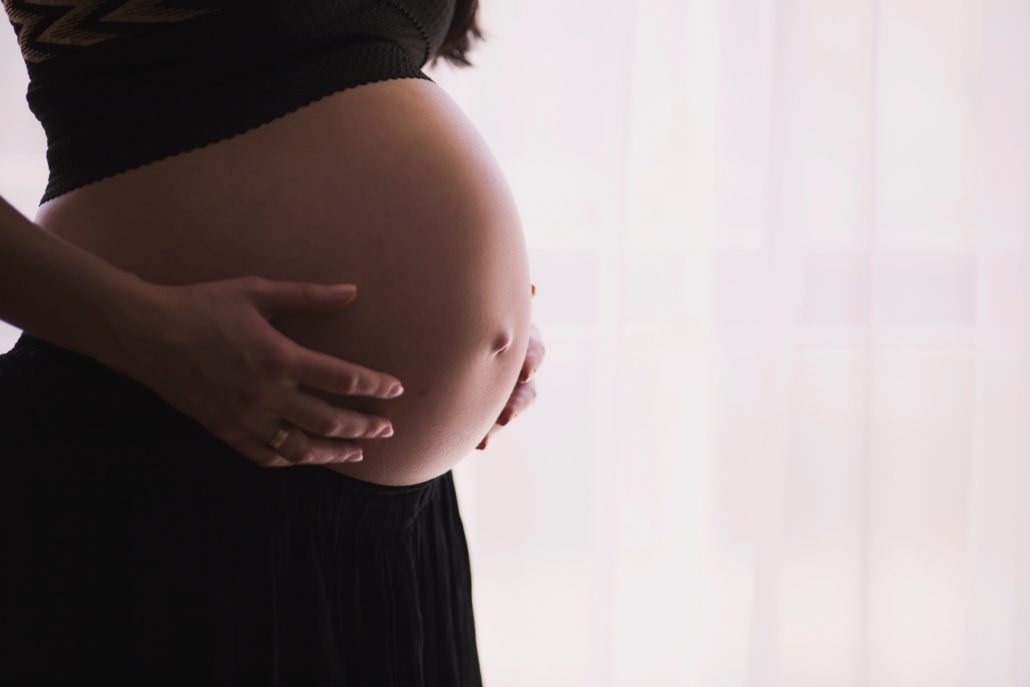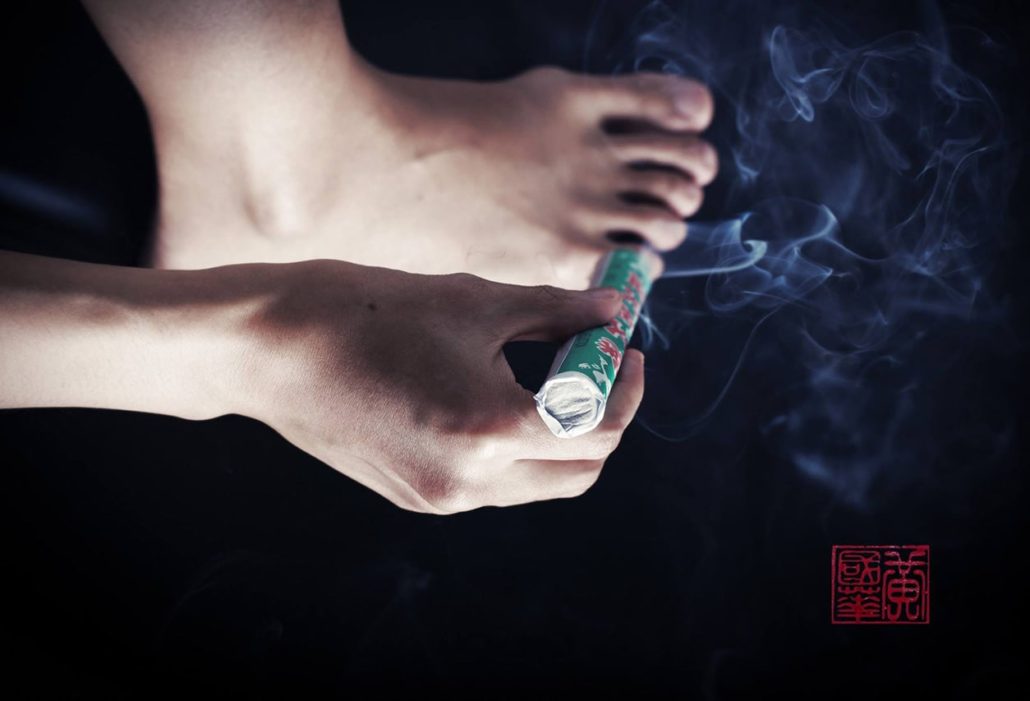Acupuncture and Moxibustion for Breech Baby

The positioning of your baby is something that becomes of greater concern in your third trimester. One of the biggest issues that comes up for many 3rd trimester mothers is finding out their baby is in a breech position.
About 25% of babies are breech before 28 weeks. At 32 weeks this number drops down to 7%. By the time the pregnancy is full-term, this number drops down further to 3-4%. In order to avoid a c-section, many women with breech babies turn to various modalities to help turn their child into a head-down position. Overall, mothers are taking a more proactive approach. It is for this reason that acupuncture, moxibustion, postural exercises, and chiropractic care are becoming more and more popular and sought out by the birthing community.
The goal of this article is to help you understand the basics behind acupuncture and moxibustion treatment for breech babies and what you can expect from it. Topics we’ll be covering are:
- How does acupuncture and moxibustion help naturally turn breech babies?
- When is the most effective time-frame to receive the treatments?
- What your acupuncturist will do in your session.
- Does it really work: what does the research say?
- Is it safe?
Breech Baby Basics
Breech positioning is basically when your baby is in a bottom or feet-first position as opposed to a head-first position. As the statistics earlier showed, quite a large number of babies are breech before 30 weeks. Around this time, your baby’s head becomes big enough to encourage a downward flip via gravity’s help and to position itself nicely head down. If you are interested in the more nitty-gritty details of breech positioning check out this article by Spinning Babies.
The biggest issue with breech positioning for mothers is that it will lead to a planned c-section. There are not many doctors or midwives in the United States that are trained in breech deliveries anymore, and so, protocol is geared towards having these babies delivered surgically. For many women who have envisioned a vaginal or natural birth, a breech position can be a giant obstacle towards realizing their plan.
If the baby is still in a breech position by 36 weeks your doctor may suggest performing an external cephalic version (ECV) around 37 weeks. The procedure involves the doctor using pressure with their hands on your abdomen to try and maneuver the baby into a head down position. The procedure is done at a hospital and the baby’s heartbeat is monitored to ensure the safety of the child. For many women on the natural birth route, an ECV can be seen as a sort of final effort to try and turn the child.
How does Acupuncture Help Naturally Turn Breech Babies?
Acupuncture involves the placing of sterile, hair-thin acupuncture needles into specific points on the body to create a therapeutic effect. The therapeutic effect depends on the root cause of the situation. In other words, what imbalance in the body is causing the breech position.
While there is no concrete certainty behind what causes a breech presentation, the following are a few theorized reasons:
- Under-functioning thyroid (hypothyroidism)
- Low lying placenta or other compromising position that affects the baby’s ability to turn
- Pelvic imbalances that affect the shape and space of your womb
While pelvic imbalances and placenta positioning seem like more direct contributors to your baby’s positioning, it’s fascinating that something like thyroid health can influence the situation. It is for this reason, that your acupuncturist must take a look at your body’s entire constitution. Addressing your entire health is a necessary part of supplying your body with the support it needs to encourage a head-down positioning.
If your thyroid is under-functioning and causing symptoms like constipation, poor energy, and dry skin throughout your pregnancy, then it would be important to address that imbalance with acupuncture when you come in for a breech treatment.
Another very common issue is imbalances in the hip or pelvis region. This may be due to too tight or loose uterine ligaments and muscles. These inequalities can cause the sacrum to “twist” or be asymmetrical and in turn, this can cause the shape of the uterus to be altered as well. This affects the space in which the baby resides and as a result, can contribute to a breech positioning. Acupuncture helps with these muscular and ligament imbalances and helps create space for the baby to turn.
It is interesting to note that there can often be an emotional component involved in tightness of the hips or a misaligned sacrum. In acupuncture, there is the basic belief that the body contains multiple pathways on it. Think of them as freeways. These freeways run along different parts of the body, connecting with different muscles and organs. They have their own functions. They also correlate with different emotions. It is believed in Chinese medicine that holding on to strong emotions long-term can damage and compromise the function of the different freeways. It’s no coincidence that that freeway related to frustration and anger runs across the neck and shoulders. It also happens to be the same freeway that runs along the hips and sacrum. It’s for this reason that when it comes to sacrum misalignment, your emotional well-being is also taken into account and addressed.
Moxibustion for breech baby: What is it and how does it work?
Moxibustion (commonly referred to as moxa) is a heating therapy where acupuncture points on the body are stimulated with heat using the herb mugwort. Moxa is commonly used for many different types of ailments in Chinese medicine, and one of its most prominent uses is to help turn a breech baby naturally.
The moxa treatment is done daily for 10 consecutive days. The first treatment is done with your acupuncturist, after which they will teach you how to perform the treatment by yourself at home for the next 9 days. The home treatment will be explained in further detail below.
Moxa is performed on a single acupuncture point on the little toe, called Bladder 67. While there is no concrete evidence for its mechanism of action, its is believed to work by stimulating production of placental oestrogens and prostaglandins (1). The increase causes movement or contractions of the uterine muscle which in turn encourages the baby to move, ideally into a head-down position.
Moxibustion Therapy Instructions: Step-by-Step

During your first acupuncture treatment, your physician will teach you how to perform the moxa on yourself at home. A course of moxa for breech presentation is 10 days long. If the baby has not turned head-down, a second course of 10 days is performed provided there is still enough time.
An important thing I always mention to patients is to continue the treatment until the 10th day even if the baby turns before. Also, it is normal for the baby to become more active during and right after the moxibustion therapy. The movement is a good thing because it creates the possibility for repositioning.
Items needed:
- Moxa stick
- Candle
- Ashtray
- Mason jar
Instructions:
- Using a candle or lighter, light one end of the moxa stick. It may take a few minutes for the stick to really absorb the heat and start glowing red. Think of it as charcoal, it takes a bit of heating up before it can become a self-sufficient form of heat.
- Moxa will be performed on the acupuncture point Bladder 67. The point is located at the outer corner of your pinky toenail.
- Steadily hold the moxa stick 1-2 inches away from the point. You will feel a gentle warmth on the skin. You want the sensation to be comfortably warm. Once it becomes uncomfortable or too hot, you can move the stick back a little bit. Never let the moxa stick touch the skin.
- Perform this for 15 minutes on one side, and then do the same thing on the other foot’s little toe for the same amount of time.
- As the moxa stick burns, it will generate ash. Scrape the ash off the stick every few minutes onto your ashtray. If there’s too much ash, it can fall off the stick and unto the skin causing a burn.
- When you’re done with the treatment, place the stick in the mason jar and seal the lid tight in order to put out the heat.
It is possible to perform the the moxa on yourself, however, I recommend that you have someone else do it for you. This allows you to relax and fully experience the treatment. After the moxa, I usually have my patients do a round of postural exercises that encourage the baby to turn like forward leaning inversions and breech tilts.
This treatment is done once a day for 10 days.
When Should I Receive the Treatment?
The ideal time to receive this type of treatment is between 32-34 weeks. At this point in time, the fetus is not too big and there is generally sufficient time and space to help the shift in position happen. In my clinical practice, we sometimes begin the treatments as early as 30-31 weeks if we find out the baby is breech via ultrasound. We want to tackle the root issue as soon as possible if there are structural imbalances in the pelvis or other potential causative factors. Solving these imbalances earlier helps us avoid the anxiety of “racing against the clock” towards the end of the pregnancy.
If the treatments bear no effect on the positioning of the fetus, the final option would be to undergo an ECV, which was mentioned at the beginning of the article. This is not performed any earlier than 37 weeks.
Putting it all Together
When I see patients for breech presentations, we are rarely doing just acupuncture and moxa. I am a firm believer in collaborative care and its synergestic effects. If you are able to approach the issue from different angles and perspectives, you are more likely to get a more well-rounded result.
The top three things our breech position patients are doing:
- Acupuncture and moxa
- Chiropractic care
- Postural Exercises
Chiropractic care is great because they can further work on any physical or structural misalignments through soft tissue work and adjustments. There is even a specific technique for working with Breech positioning called Webster technique. Find a chiropractor who is experienced with this technique.
Postural exercises are incredibly important! The way we carry our bodies and the positions we tend to keep our bodies in can have incredible effects on our pelvic alignment. A big one is to try and keep your knees below your hips when sitting. This means avoid “lazy” chairs where your buttocks and hips sink lower than your knees. This contracts the space in the lower part of the womb, giving your baby less space to turn head-down into. In terms of actual exercises to perform: check out the Spinning Babies website. They have an excellent array of different postures to perform that help with aligning the pelvis and encouraging the baby to flip head-down.
Is Moxibustion and Acupuncture Safe during the Third Trimester?
Yes, when performed by a licensed professional who is experienced with prenatal care.
According to a 2019 review of all the major studies done on moxa for breech presentations, it was concluded that “all the systematic reviews agreed that there are no adverse effects directly related to moxibustion and acupuncture technique, so it seems to be safe” (2).
What does the research say? Does it really work?
Like all things, there is no guarantee of success. It is for this reason that I always recommend a three-pronged approach of different modalities to ensure that you’re doing all that you can to set you up for the highest chance of success.
There have been a number of studies done on moxibustion’s efficacy for turning breech babies. Below is one of the most studies published in a peer-review journal.
In 2019, the Evidence-Based Complimentary and Alternative Medicine journal published a research paper on the efficiacy of moxibustion for turning breech babies at 32-35 weeks (3).
Who: The study included 93 women who were 32-35 weeks pregnant and had a breech presentation
Intervention: The women received moxa therapy on the acupuncture point Bladder 67 once a day for two weeks. If they were still breech after the 2 weeks, they did another round of moxibustion + acupuncture treatment for three days.
Results: 62.4% of the women had their babies turn head-down and delivered vaginally. It was concluded that moxa therapy could be an effective, low-cost treatment for turning breech babies.
References
1) Cooperative Research Group of Moxibustion Version of Jangxi Province. Further studies on the clinical effects and mechanism of version by moxibustion. Abstracts of the Second National Symposium on Acupuncture, Moxibustion, and Acupuncture Anesthesia; 1984 Aug 7‐10; Beijing, China. 1984:150‐1.

